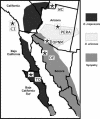Early events in speciation: polymorphism for hybrid male sterility in Drosophila
- PMID: 15184657
- PMCID: PMC428463
- DOI: 10.1073/pnas.0403106101
Early events in speciation: polymorphism for hybrid male sterility in Drosophila
Abstract
Capturing the process of speciation early enough to determine the initial genetic causes of reproductive isolation remains a major challenge in evolutionary biology. We have found, to our knowledge, the first example of substantial intraspecific polymorphism for genetic factors contributing to hybrid male sterility. Specifically, we show that the occurrence of hybrid male sterility in crosses between Drosophila mojavensis and its sister species, Drosophila arizonae, is controlled by factors present at different frequencies in different populations of D. mojavensis. In addition, we show that hybrid male sterility is a complex phenotype; some hybrid males with motile sperm still cannot sire offspring. Because male sterility factors in hybrids between these species are not yet fixed within D. mojavensis, this system provides an invaluable opportunity to characterize the genetics of reproductive isolation at an early stage.
Figures



Similar articles
-
Post-zygotic isolation in cactophilic Drosophila: larval viability and adult life-history traits of D. mojavensis/D. arizonae hybrids.J Evol Biol. 2009 Jul;22(7):1387-95. doi: 10.1111/j.1420-9101.2009.01753.x. Epub 2009 Jun 5. J Evol Biol. 2009. PMID: 19508411 Free PMC article.
-
Genetic architecture of hybrid male sterility in Drosophila: analysis of intraspecies variation for interspecies isolation.PLoS One. 2008 Aug 27;3(8):e3076. doi: 10.1371/journal.pone.0003076. PLoS One. 2008. PMID: 18728782 Free PMC article.
-
An autosomal factor from Drosophila arizonae restores normal spermatogenesis in Drosophila mojavensis males carrying the D. arizonae Y chromosome.Genetics. 1993 May;134(1):309-18. doi: 10.1093/genetics/134.1.309. Genetics. 1993. PMID: 8514139 Free PMC article.
-
Advances in the genetics of reproductive isolation in Drosophila.Genome. 1989;31(1):211-20. doi: 10.1139/g89-036. Genome. 1989. PMID: 2687092 Review.
-
Sperm fate and function in reproductive isolation in Drosophila.Soc Reprod Fertil Suppl. 2007;65:155-73. Soc Reprod Fertil Suppl. 2007. PMID: 17644960 Review.
Cited by
-
Post-zygotic isolation in cactophilic Drosophila: larval viability and adult life-history traits of D. mojavensis/D. arizonae hybrids.J Evol Biol. 2009 Jul;22(7):1387-95. doi: 10.1111/j.1420-9101.2009.01753.x. Epub 2009 Jun 5. J Evol Biol. 2009. PMID: 19508411 Free PMC article.
-
Genetic architecture of hybrid male sterility in Drosophila: analysis of intraspecies variation for interspecies isolation.PLoS One. 2008 Aug 27;3(8):e3076. doi: 10.1371/journal.pone.0003076. PLoS One. 2008. PMID: 18728782 Free PMC article.
-
Fertilisation and early developmental barriers to hybridisation in field crickets.BMC Evol Biol. 2013 Feb 15;13:43. doi: 10.1186/1471-2148-13-43. BMC Evol Biol. 2013. PMID: 23410054 Free PMC article.
-
Low fertility of wild hybrid male flycatchers despite recent divergence.Biol Lett. 2013 Apr 10;9(3):20130169. doi: 10.1098/rsbl.2013.0169. Print 2013 Jun 23. Biol Lett. 2013. PMID: 23576780 Free PMC article.
-
Hybrid incompatibility between Drosophila virilis and D. lummei is stronger in the presence of transposable elements.J Evol Biol. 2022 Oct;35(10):1319-1334. doi: 10.1111/jeb.14079. Epub 2022 Aug 21. J Evol Biol. 2022. PMID: 35988129 Free PMC article.
References
-
- Haldane, J. B. S. (1922) J. Genet. 12, 101-109.
-
- Orr, H. A. & Presgraves, D. C. (2000) BioEssays 22, 1085-1094. - PubMed
-
- Muller, H. J. (1942) Biol. Symp. 6, 71-125.
-
- Muller, H. J. (1940) in The New Systematics, ed. Huxley, J. (Clarendon, Oxford), pp. 185-268.
Publication types
MeSH terms
LinkOut - more resources
Full Text Sources
Medical
Molecular Biology Databases

